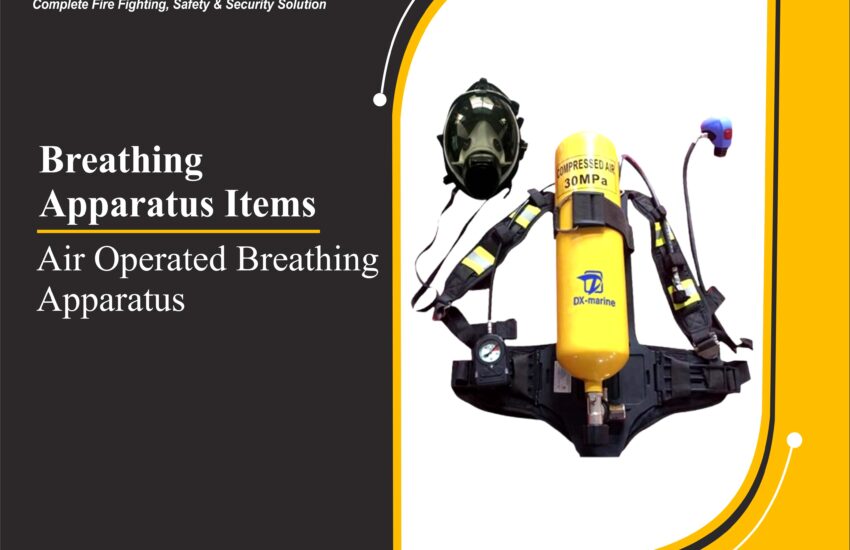Air Operated Breathing Apparatus (SCBA) is essential personal protective equipment (PPE) for environments with toxic gases, low oxygen levels, or heavy smoke. Professionals such as firefighters, emergency responders, and marine crews rely on SCBAs to breathe safely during hazardous operations.
This apparatus consists of a facemask, air cylinder, high-pressure reducing valve, warning alarm, pressure gauge, and a secure harness. It operates using positive pressure, which means the air inside the mask remains higher than atmospheric pressure. As a result, contaminated air cannot leak inside.
Technical Specifications of the SCBA
Understanding the technical details of the SCBA is crucial for proper operation and compliance.
Gas Cylinder
- Capacity: 6 Litres
- Material: Alloy Steel
- Working Pressure: 0–30 MPa
- Air Content: At least 1200 litres of breathable air
Pressure Regulator
- Maximum Outflow: 450 L/min
- Output Pressure: 0.7 ± 0.05 MPa
Safety Valve
- Opening Pressure: Between 1 and 1.2 MPa
Alarm System
- Activation Pressure: 5.5 ± 0.5 MPa
- Sound Level: 95 dB
- Flashing Rate: 60 times per minute
Performance Metrics
- Respiratory Resistance: Less than 980 Pa
- Service Time: More than 30 minutes
- Package Dimensions: 728 x 440 x 300 mm
- Weight: 16 kg (excluding the lifeline)
Component Overview and Functionality
The SCBA includes several integrated components, each serving a vital role in user safety.
- Face Mask: Provides a full seal and operates under positive pressure, ensuring that no toxic gases enter the mask.
- Demand Valve: Automatically adjusts airflow. In emergencies, users can override it to increase air volume.
- Backplate & Harness: Designed for comfort and stability. It securely holds the cylinder in place during use.
- Pressure Gauge: Displays real-time air pressure, allowing the user to monitor remaining air supply.
- Warning Whistle: Sounds an alert when pressure drops to a critical level, prompting evacuation.
- Lifeline: Made from galvanized steel wire covered in rope, extending at least 3 meters beyond the required length for escape.
- Spare Cylinders: Each set includes spares with a minimum total air capacity of 2400 litres.
Cylinder Requirements and Exceptions
In standard conditions, each SCBA set should have two spare charged cylinders. However, there are a few exceptions:
- For vessels with five or more SCBA sets: Total spare capacity must be at least 9600 litres.
- For ships with onboard refill capabilities: Each set requires only 1200 litres of spare air, and total capacity across the ship must not exceed 4800 litres.
Additionally, ultra-lightweight cylinders require extra care. Operators must ensure the air used for refilling is moisture-free, and they must regularly inspect cylinder integrity.
Air Compressor Guidelines
To support SCBA operations, many ships carry dedicated air compressors. These may be either fixed or portable.
- Install compressors in clean, ventilated environments to avoid contamination.
- Ensure the air intake system stays free from water, fumes, and pollutants—even in adverse weather conditions.
SCBA Maintenance and Inspection Procedures
Proper maintenance extends the life of SCBA gear and guarantees performance in emergencies.
Routine Post-Use Checklist
After each use, operators should:
- Thoroughly clean the set and face mask using warm soapy water.
- Inspect for damage, loose parts, or signs of wear.
- Replace the used air cylinder with a fully charged one.
- Perform both high and low-pressure tests.
- Disinfect the face mask with approved solutions.
- Re-stow the apparatus in a ready-to-use condition.
- Complete maintenance and usage records immediately.
Following these steps ensures the equipment remains in top condition for the next deployment.
Training Requirements
Regular training significantly improves the safe and effective use of SCBA equipment. Crew members designated to use SCBAs must receive frequent, hands-on training sessions.
As they gain confidence and familiarity with the device, they will respond more effectively during real emergencies. Training should include donning and doffing, emergency procedures, and equipment checks.
Important Safety Guidelines
To prevent accidents and ensure user safety, follow these essential precautions:
Cylinder Validity
- Each cylinder is valid for 15 years.
- Always verify the cylinder’s validity before recharging.
- Never overfill a cylinder beyond its specified pressure.
Compressor Safety
- Only use compressors located in clean air environments.
- Dirty or contaminated environments can result in unsafe air being pumped into the cylinders, causing internal damage.
Cylinder Quality
- Avoid using low-quality or damaged cylinders.
- Faulty cylinders may lead to severe accidents, including explosions.
Power Failure Protocol
If the compressor shuts down unexpectedly:
- Immediately turn off the power switch.
- Inspect the unit for malfunctions.
- Resume operations only after confirming it is safe to do so.
Conclusion
The Air Operated Breathing Apparatus (SCBA) remains an indispensable part of fire safety and emergency response equipment. By providing a steady supply of clean, compressed air, it protects users in the most hazardous conditions.


